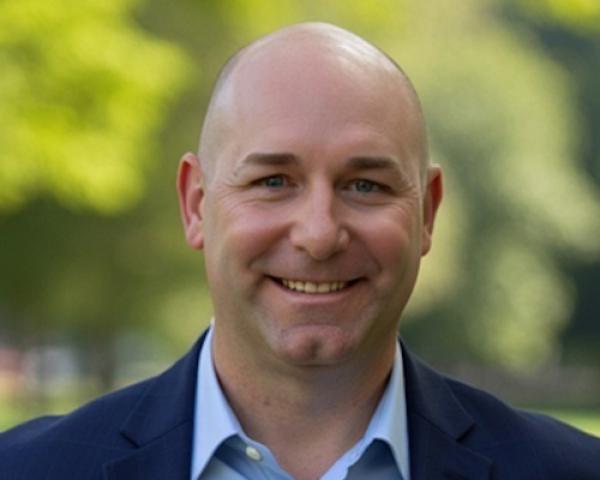I’ve always enjoyed a good magic trick. It gives you a momentary suspension of reality to believe that there is something more. There is also the desire to figure out how they did it, how did they know that your card was the 10 of clubs, how did they walk through a solid wall, how did they violate the laws of physics? But, while the trick is entertaining, you always know that they did not actually saw someone in half and then reverse the process in less than a minute. You know that the rabbit did not dematerialize. You know that the person is not really floating in midair, levitating without strings. You lose yourself in the wonder of it all, but realize that it was just an illusion.
There is a somewhat painful parallel with predictive analytics and insurance. On the one hand, there is great promise to change the entire industry, suspending the well-worn rules of insurance and the doctrines taught since the beginning. We look with wonder at the almost messiah-like prophecies of insurtech and how it will kill multibillion-dollar insurance organizations and entire distribution ecosystems at the touch of an icon.
But then we start to wonder, how will it actually work? How will companies choose which risks are acceptable and at what price? How will they go from losing money on every policy into a sustainable business model that not only generates revenue for today but adequate reserves and reinsurance for tomorrow? How will the buying public intelligently evaluate different policies and coverages when they do not speak insurance-ese?
Just because data may be available, it does not automatically follow that this information is useful, credible and legitimate or can be legally employed. This is the now you see it, now you don’t part of insurance and predictive analytics. But before we delve into it, let’s take a moment to review some fundamentals.
First — insurance is the largest single industry on the planet, accounting for 7% of the global economy. It has been called the grease that lubricates the global economy. It is virtually impossible to think about anything where insurance is not at the heart. Nothing gets built, no commerce moves, no innovation or transaction takes place without insurance playing a major role.
Second — insurance is the original data-driven industry. Insurance has no converting of raw physical materials into a finished product. At its core, insurance is words, a promise, a contract that lays out rules and responsibilities of the parties. And this is an important lead up to the next fundamental.
Third — insurance is NOT a commodity. Of all the things written and bandied about regarding insurance, this is the single most important misconception being spewed by people who have their insurance feet firmly planted in the air, using both social and traditional media for the uncontrolled spread of this false insurance news. You can take out your ruler to measure if the two pieces of lumber are the same height, width and length. Or if the jar of salsa contains 16 ounces or not. Because insurance is the original data-driven industry, there are no physical dimensions to measure or evaluate. Comparing plan premiums and deductibles only scratches the surface.
Let me paint a word picture that I hope will make this clear. Imagine that I have five plastic tubes in my hand. To the casual observer, they look similar in size, color and caps. I submit that you would not mindlessly grab a tube and put its contents into your mouth without carefully reading the label and ingredients. You would do this because the tubes, while similar in appearance, could actually contain:
- Toothpaste
- Anti-bacterial soap
- Acrylic paint
- Brass cleaner
- Hemorrhoid cream
For an actual insurance example, an insurer’s “HO3” provides Coverage A – dwelling coverage. Some Coverage A descriptions say, “This coverage does not apply to any dwelling used in whole or in part for ‘business.” Do you ever conduct business from home? Recent studies suggest that half of Americans work from home at least occasionally. If your policy reads like this, then you probably do not have dwelling coverage. Another example comes from Coverage C – personal property. Some policies say it covers personal property “while it is IN” the “residence premises.” This eliminates any personal property that was not directly in the residence.
See also: 3 Key Steps for Predictive Analytics
And the worst possible time to discover that your property will not be replaced is when you’ve had a loss.
Something less than the holy trinity
Fourth — sometimes referred to as the something less than holy trinity, Standards, compliance and regulation play important roles within the insurance industry.
- Standards — with very rare exceptions, there basically are no meaningful standards within the insurance industry when it comes to policy language, pricing or data. Yes, there are forms and rates published by organizations, but carriers are very creative in creating unique coverages, wording, pricing and underwriting selection criteria. We know this to be true for at least three reasons. When an insurance agent moves a policy from carrier A to carrier B, the agent is strongly encouraged to review differences with clients or face a potentially painful and expensive E&O claim for policy differences that were not explained and signed off. Another reason that we know this to be true is that you cannot take data from a policy download from carrier A and upload it to carrier B. And thirdly, if there were meaningful standards, then there would be no need for comparative rating software.
- Compliance — across the country, there is an unbelievably complex web of compliance requirements. Not only are there state insurance commissioners, but some states split out workers' compensation from other forms of insurance. Insurance products must comply with individual jurisdictional requirements, or substantial fines can be levied. As an example, check out the press releases on the fines charged to Zenefits for its part in selling insurance without the use of authorized, licensed insurance agents.
- Regulation — In 12 states, insurance commissioners are elected, providing additional political pressure to lower rates while raising coverage, especially in an election year. On top of the state requirements, some cities have their own insurance requirements which are layered on top of, and sometimes conflict with, the state requirements when it comes to required coverage, price, covered claims and taxes.
Data sources
Because insurance is the original data-driven industry, insurance organizations are a treasure trove of information that they have been collecting since their inception. Perhaps this is why both artificial intelligence and predictive analytics zealots salivate at the prospects of getting access to this information.
There are three potential data sources available to insurance organizations that could feed predictive analytics; traditional, obvious and hidden.
Traditional — these are data sources employed today within the insurance industry. It all starts with information collected on an application. From there it spreads out to include vehicle/property data, employment and payroll data, replacement cost estimators, credit scores, actuarial tables, claims history, location/ZIP codes and beyond.
But even with all this information, there is no uniform application of it throughout the industry, among companies or even within a state. For example, there is ample statistical evidence proving that insurance credit scores are solid predictors of claims severity. Some carriers use insurance credit scores extensively while others ignore it altogether, even in the same competing markets. In personal auto and homeowners, premiums can more than double based solely on the insurance credit score of two identical insureds in the same state. In California and Massachusetts, you are not permitted to use insurance credit scores in either personal auto or homeowners, while in Maryland you can use it in personal auto but not in homeowners.
This is a classic example of the “now you see it, now you don’t” aspect of insurance data and predictive analytics. Data is available, but not everyone elects to use it. Also, there are regulatory restrictions on when and where the data can be employed.
It's important to understand that, unlike traditional credit scores, which are used by lenders such as credit card issuers, consumers don't have access to their credit-based insurance reports. This helps fuel the fires of mistrust that the American people feel toward insurance. One study concluded that, in most states, “auto insurance premiums are driven in large measure by economic factors that are unrelated to driving safety” — namely, education level, occupation, homeownership status, prior purchase of insurance and marital status. It also found that a substantial majority of Americans believe it is unfair for insurance companies to use economic characteristics – specifically, education level, occupation, not having insurance because of not having a car, homeownership status, marital status, and credit score – in setting auto insurance premiums. For example, good drivers pay 59% more, or $681 annually, on average for auto insurance due to personal characteristics associated with lower economic status.
Obvious — there are a number of new and exciting data sources that have clear and observable usage for insurance and predictive analytics. They may be obvious to the casual observer, but privacy and political concerns may move them into the questionable category.
While telematics has been used by some insurance companies, I don’t think of it as a traditional data source because of the emergence of your vehicle not only as a means of transportation, but also as a data hub. In addition to vehicle and driver performance, data from vehicle hands-free cell phone usage, entertainment and vehicle hotspot connections are available. This allows non-driving data and patterns to be compared and scored, potentially altering premiums and whether you are a desirable insurance customer.
Social media is another obvious data source, but how should it be employed within the insurance marketplace? For example, should your social media posts be used to select whether an insurance company is willing to insure you, and at what price? Also, should social media information be criteria to deny a claim? Recently, a couple applied for personal umbrella liability insurance to be added to their homeowners policy. As part of the application, they had to list the number of dogs they owned and their breeds, which they truthfully answered. They were shocked to find that they were not only rejected for the extra insurance but that their homeowners policy was being canceled as well because the company claimed they had a Rottweiler mix, a dog breed the company considers dangerous. The most intriguing part of the story was that the insurance carrier used pictures from Facebook as proof that the coupled had “lied” on the application. The couple followed up with the insurance company to let it know it was wrong about the dog’s breed. Instead of standing down, the insurance company said it would need a written letter from a veterinarian. This was no problem, because the wife was a veterinarian. The insurance company eventually offered to reinstate the policy, but the couple took their business elsewhere and lamented, “Be careful about what you post on Facebook. It’s sad that you can’t post pictures of your beloved pet on your own Facebook page."
There are mountains of data available on individuals and corporations that are in the public domain. The federal government collects and publishes reams of data, and there is precious little that you can do about it. Some examples include census data, name and addresses of all licensed pilots, whether your address is on a flood plain. The surveillance, epidemiology and end results (SEER) program of the National Cancer Institute Program provides information on cancer statistics in an effort to reduce the cancer burden among the U.S. population. By keeping this data, SEER details when/where cancers are breaking out. Local governmental data sources include information on physicians and attorneys, and your water bill is also in the public domain. One of the more interesting non-governmental sources is information for all loans issued through the Lending Club, including the current loan status (current, late, fully paid, etc.) and latest payment information. And we won’t even go into amount of free data that is available via Facebook.
The Internet of Things, IoT, is providing unparalleled additional information into the details of our lives. Just about any type of device for your home, office or health is collecting data to learn more about out preferences and habits, which is potentially available to affect your insurance acceptability and pricing. Even iRobot’s Roomba is collecting data about dimensions of a room as well as distances between sofas, tables, lamps and other home furnishings.
Phone companies can track which cell tower your call is pinging. Credit/debit card companies are tracking payment details. Some of this may/may not be available today, but the shifting sands of privacy certainly will alter the status quo.
Hidden — there are a growing number of non-obvious data sources that contain potentially valuable or questionable information about our lives that may be applied to insurance. We will discuss the sources and then whether they should be used within insurance.
One insurance company uses the customer’s email domain name in pricing personal auto policies: “Certain domain names are associated with more accidents than others. We use a variety of pieces of information to accurately produce a competitive price for our customers.” This hidden piece of information leads to different pricing for Hotmail email account users instead of a Gmail one. It was also found that this insurance company charged significantly more for insureds with foreign-sounding names.
Intelligent personal assistants, IPAs, are becoming more and more popular each and every day. Organizations from every industry, including insurance companies, are tapping into this easy-to-use technology that is only a spoken word away. Amazon and Google are leading the pack, with Microsoft and Apple in hot pursuit. The good news is that all you have to do is talk, and the IPA is there to grant your every wish. The bad news is that for IPAs to answer your request, they have to be listening. And not just listening but listening all the time. It is unclear how much of the conversation is actually saved and how it is being used. But as we know all too well, once something is saved, it is almost never fully erased; there are digital cookie crumbs to be followed. There was a case where police subpoenaed the recordings made by an IPA in a house where a murder was committed. Should this information be made available to the police? Should it be made available to insurance companies?
You can be certain that everybody, and I mean everybody, including smart phone apps, fitness monitors, retail and grocery stores, rental car companies, cable companies, etc. are collecting lots of data about you, your life choices, lifestyles and buying habits. For many of the obvious and hidden data sources, the public is giving away their data and rights to restrict how it might be used. Why do you think everyone offers free memberships, convenient apps and customer loyalty rewards? It’s not that they enjoy giving things away. While you cannot be certain about a great many things in this life, one thing that you can go to the bank about is that they think it’s worth the time, energy and money to collect this data to monetize it. I know it’s even less exciting than watching paint dry, but stop and try to read through the entire user agreement before mindlessly clicking on the “I Agree” EULA (End-User License Agreement) button. If you read these agreements in detail, you will find that you are providing the right to collect just about everything you can imagine and then some, and then letting the company do with it whatever it thinks best. One car rental user agreement I reviewed said the company had the right not only to the vehicle telematics data, but also to your Facebook information. Now I really cannot connect the dots between a car rental and my Facebook data, but the company apparently think it’s worth it.
My favorite example of hidden information is mapping data. I love how I can enter a destination and see the best route, with/without tolls, and even see changes in the route in case of changing traffic patterns caused by roadwork or accidents, and at no cost. This is great technology that I am thankful for each and every day. However, in case you were not aware, smart phones with mapping tools are also recording your movement as long as the phone is on, even when you are not using the map app. They have my detailed movements on file since December 2012. I can look up, by day, where I went, including the places of business I visited. Do you think an insurance company might be interested if you:
- Changed your normal travel patterns?
- Visited a local watering hole after work?
- Started going to a cancer treatment center?
- Went to an AIDS clinic?
- Stopped in a medical or recreational marijuana store?
- Drove to a psychiatrist three times a week?
As I said, this is great technology, and it doesn’t cost me a thing. Or does it?
A personal example
If you were to look at my available data during the early summer of 2016, you would see a change in my travel patterns, mapping, spending and social media information. You could easily determine that something had changed, triggering a more detailed look in my traditional, obvious and hidden data. You would have found that I started visiting a dermatologist quite frequently, and stayed for long periods. You would have seen pictures and posts on social media about multiple visits and procedures to identify, remove and then remove again more tissue associated with melanoma. While I am thankful that the doctors were able to remove it after multiple surgeries, would an insurance company be interested in this kind of data?
Or perhaps the more daunting question is whether an insurance company should be interested in this kind of data? There is no question that the data is there (now you see it). But the more difficult question is whether or not the insurer should be allowed to employ it (now you don’t).
See also: What Comes After Predictive Analytics
Bill Hartnett, sometimes called the “godfather” of Microsoft financial services, puts it succinctly; “Predictive analytics has a dark side. Price and claim optimization should have no place in insurance. Determining that you are willing to pay a price higher than your underwriting risk indicates based on past buying behavior, or accept a claim settlement less than the actual cost based on your financial situation is not insurance.”
Bill Wilson, CPCU, ARM, AIM, AAM, founder and CEO of InsuranceCommentary.com, puts it more bluntly, “All insurance regulators who have considered the issue of price optimization have concluded that it has no place in underwriting and pricing insurance. Most state insurance laws expressly require that rates and premiums be risk-based and not unfairly discriminatory. The insurance industry is one founded, like few others, on the overriding principle of utmost good faith. Price optimization is about as far as you can get from good faith.”
Application
These are some formidable questions, requiring both discussion and research. Intel, IBM, Workday and the Washington, D.C.-based Information Technology Industry Council—whose members include Facebook, Apple and Google—all issued principles on the ethical use of artificial intelligence. Microsoft put out an entire book on “Artificial Intelligence and its Role in Society.” Some of the biggest tech companies founded an ethics-setting organization called the Partnership on Artificial Intelligence to Benefit People and Society, based in San Francisco. There are many others including Open AI, the AI Now Institute, doteveryone and the Center for Democracy and Technology.
It would seem reasonable that because insurance is the single largest industry on the planet, and consumes nothing but data, representatives from the insurance industry participate in these cross-industry forums.
So, where do we go from here? I’d like to suggest two ways to move forward, but their source and inspiration are miles apart from insurance.
First — predictive analytics and insurance is a journey, not a destination. The inspiration for this is Heraclitus of Ephesus (535 BC – 475 BC.) Now I admit that insurance, technology and ancient Greek philosophers don’t have a whole lot in common, at least on the surface. Heraclitus wrote, “Everything changes, and nothing remains still. You cannot step twice into the same stream.” He was saying that if you step into a stream, step out and then right back in, you are stepping into a different stream. The water around your feet during the first step will be different than the second. The air around you is different. The birds in the air are no longer in the same place. And so it is with predictive analytics and insurance. What was commonplace and known last year is way out of date. The assumptions and tools are better and different now than just months ago. This requires continuous investment, evaluation and adjustment of your predictive analytics plans and application. There needs to be a continuing collection and evaluation of data sources, quality and efficacy.
Second — predictive analytics and insurance requires that we treat people well. The works of Robert Neelly Bellah (Feb. 23, 1927 – July 30, 2013) are the inspiration for this application. He was an American sociologist, and the Elliott Professor of Sociology at the University of California, Berkeley. Robert wrote about something he called “expressive individualism,” where each person has a unique core of feeling and intuition that should unfold or be expressed if individuality is to be realized. Each person has the need to express needs, wants and desires. Throughout the predictive analytics implementation process within insurance, we need to treat people individually and always lead with respect. Today’s insurance marketplace needs to move way beyond the current mania of mail-merge marketing memos. Another thing to avoid is acting creepy, using so much information that you make the customer feel uncomfortable.
Winners within the insurance marketplace will be those organizations that aggressively and systemically leverage data and predictive analytics technology while providing personalized products and services. The road to successful employment of predictive analytics within the insurance marketplace will, by necessity, require many starts and adjustments along the way. Members of the “something less than the holy trinity” will create unique challenges felt in no other industry. But great potential awaits those who start and continually move forward.
Note — this article is based on a presentation for the Global Predictive Analytics Conference, April 2-4, 2018, Santa Clara, CA.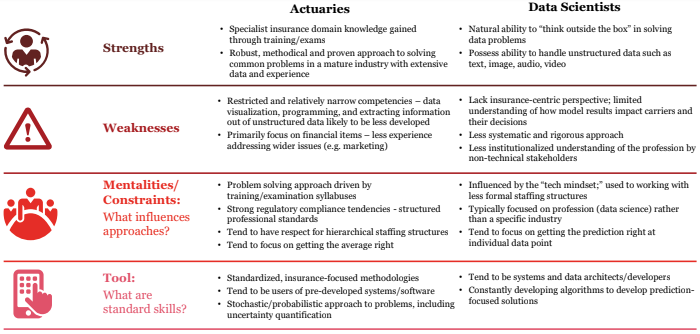 PwC sees three main ways to accelerate integration and improve combined value
1. Define and implement a combined operating model. Clearly defining where data scientists fit within your organizational structure and how they will interact with actuaries and other key functions will reduce friction with traditional roles, enhance change management and enable clearer delineation of duties. In our view, developing a combined analytics center of excellence is the most effective structure to maximize analytics’ value.
2. Develop a career path and hiring strategy for data scientists. The demand for advanced analytical capabilities currently far eclipses the supply of available data scientists. Having a clearly defined career path is the only way for carriers to attract and retain top data science (and actuarial) talent in an industry that is considered less cutting-edge than many others. Carriers should consider the potential structure of their future workforce, where to locate the analytics function to ensure adequate talent is locally available and how to establish remote working arrangements.
3. Encourage cross-training and cross-pollination of skills. As big data continues to drive change in the industry, actuaries and data scientists will need to step into each others’ shoes to keep pace with analytical demands. Enabling knowledge sharing will reduce dependency on certain key individuals and allow insurers to better pivot toward analytical needs. It is essential that senior leadership make appropriate training and knowledge-sharing resources available to the analytics function.
Options for integrating data scientists
Depending on the type of carrier, there are three main approaches for integrating data scientists into the operating model.
PwC sees three main ways to accelerate integration and improve combined value
1. Define and implement a combined operating model. Clearly defining where data scientists fit within your organizational structure and how they will interact with actuaries and other key functions will reduce friction with traditional roles, enhance change management and enable clearer delineation of duties. In our view, developing a combined analytics center of excellence is the most effective structure to maximize analytics’ value.
2. Develop a career path and hiring strategy for data scientists. The demand for advanced analytical capabilities currently far eclipses the supply of available data scientists. Having a clearly defined career path is the only way for carriers to attract and retain top data science (and actuarial) talent in an industry that is considered less cutting-edge than many others. Carriers should consider the potential structure of their future workforce, where to locate the analytics function to ensure adequate talent is locally available and how to establish remote working arrangements.
3. Encourage cross-training and cross-pollination of skills. As big data continues to drive change in the industry, actuaries and data scientists will need to step into each others’ shoes to keep pace with analytical demands. Enabling knowledge sharing will reduce dependency on certain key individuals and allow insurers to better pivot toward analytical needs. It is essential that senior leadership make appropriate training and knowledge-sharing resources available to the analytics function.
Options for integrating data scientists
Depending on the type of carrier, there are three main approaches for integrating data scientists into the operating model.
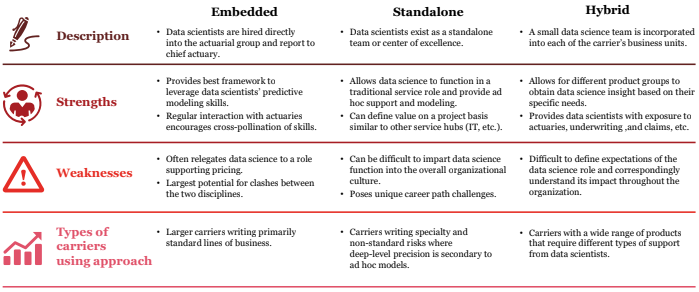 Talent acquisition: Growing data science acumen
Data science talent acquisition strategies are top of mind at the carriers with whom we spoke.
Talent acquisition: Growing data science acumen
Data science talent acquisition strategies are top of mind at the carriers with whom we spoke.
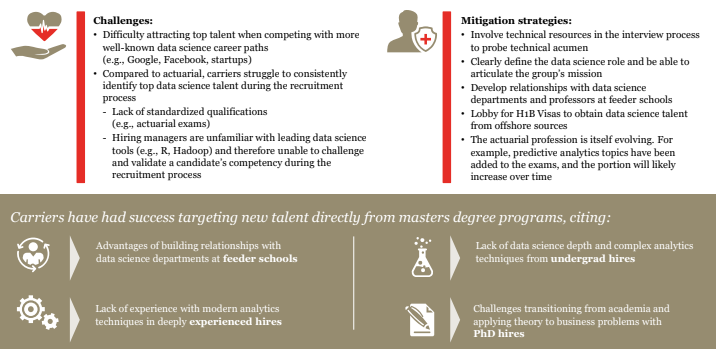 See also: Digital Playbooks for Insurers (Part 3)
Data science career path challenges
The following can help carriers overcome common data science career path challenges.
See also: Digital Playbooks for Insurers (Part 3)
Data science career path challenges
The following can help carriers overcome common data science career path challenges.
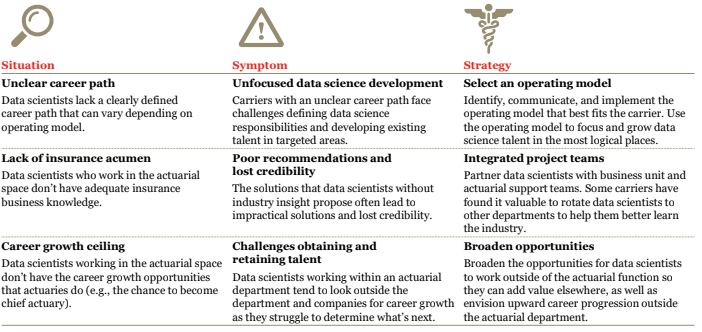 Case study: Integration of data science and actuarial skills
PwC integrated data science skills into actuarial in-force analytics for a leading life insurer so the company could gain significant analytical value and generate meaningful insights.
Issue
This insurer had a relatively new variable annuity line without much long-term experience gauging its risk. Uncertainty about excess withdrawals and rise in future surrender rates had major implications for the company’s reserve requirements and strategic product decisions. Traditional actuarial modeling approaches were limited to six to 12 months of confidence at a high level, with only a few variables. They were not adequate for major changes in the economy or policyholder behavior at a more granular level.
Solution
After engaging PwC’s support, in-force analytics expanded to use data science skills such as statistical and simulation modeling to explore possible outcomes across a wide range of economic, strategic and behavioral scenarios at the individual household-level.
Examples of data science solutions include:
Case study: Integration of data science and actuarial skills
PwC integrated data science skills into actuarial in-force analytics for a leading life insurer so the company could gain significant analytical value and generate meaningful insights.
Issue
This insurer had a relatively new variable annuity line without much long-term experience gauging its risk. Uncertainty about excess withdrawals and rise in future surrender rates had major implications for the company’s reserve requirements and strategic product decisions. Traditional actuarial modeling approaches were limited to six to 12 months of confidence at a high level, with only a few variables. They were not adequate for major changes in the economy or policyholder behavior at a more granular level.
Solution
After engaging PwC’s support, in-force analytics expanded to use data science skills such as statistical and simulation modeling to explore possible outcomes across a wide range of economic, strategic and behavioral scenarios at the individual household-level.
Examples of data science solutions include:






















